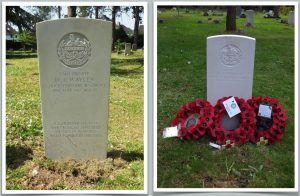5th Battalion, Gloucestershire Regiment

Henry John Waylen was born in June 1885 to Edwin Waylen and Emily (formerly Teale).
Edwin was born in Berwick Bassett in Wiltshire whilst Emily came from Overbury. They had a total of six children of whom five were still alive in 1911.
Edwin married Emily in Tewkesbury in 1877 and settled in the town, his occupation described variously as groom, ostler or coachman. By 1901 the family was living in one of the four Laurel Cottages, Parsons Row, Oldbury Road, and Henry was a pupil at the Holy Trinity Schools.
In 1911 Henry was still living at home and working as a gardener.
Henry had served as a part-time soldier before the war in the 5th Battalion, Gloucestershire Regiment, one of its three Territorial Force units.
He served from 1908 until 1913 when his time expired. The units had just departed for their annual summer camp when war broke out in August 1914 and they were at once recalled and mobilised.
Henry volunteered soon afterwards to re-join his battalion and attested at Tewkesbury on 1 September 1914.
The battalion was split into two with the men in the first-line unit (1/5th) agreeing to overseas service whilst the second-line unit (2/5th) remained in the UK for home service only.
Henry went to France with the 1/5th Battalion, landing at Boulogne on29 March 1915.
The battalion became part of the 145th Infantry Brigade, in the 48th (South Midland) Division, but was not involved in any major actions during the rest of 1915.
In 1916 Henry was sent to Salonika with Lieutenant Colonel Arthur Lionel Crisp Clarke DSO of the 27th Division (a completely different division). He embarked at Marseilles on 1 January on SS Shropshire and disembarked at Salonika on 8 January.
His role was described as ‘Servant’ to Lieutenant Colonel Clarke who was one of the General Staff Officers (there were normally three) in the Divisional HQ which, in total, typically comprised 15 officers and 67 men.
So Henry was serving in a fairly rarefied environment in the area that controlled and administered a division of some 18,000 to 20,000 men.
Henry must, therefore, have been considered a reliable and trustworthy soldier to have served in the HQ function although it’s difficult to know how he was selected for the job or if he was somehow known previously to Lieutenant Clarke who had started his military career with the Argyll & Sutherland Highlanders in the 1880s but seems to have spent the whole of the war on the General Staff in France and Macedonia (ie Salonika).
Despite having suffered no previous illnesses, Henry contracted a cough in January but remained in Salonika until he returned to England on 10 July 1916.
Henry was then diagnosed with tuberculosis and deemed no longer fit for active service.
He was categorised as ‘Total Disabled’ and discharged from the Army on 7 August 1916; since his condition was attributed to active service, he was awarded a pension of 25 shillings (£1 25p) a week, increased in the month before his death.
Private Henry John Waylen died on 2 May 1917, aged 31, presumably from the effects of his wartime illness, and he was buried in Tewkesbury Cemetery, but in a private grave and not with a Commonwealth War Graves Commission headstone.
His name was however, commemorated on both memorials in Tewkesbury.
Henry was awarded the ‘1914-15 Star’ medal. Tragically, his father, Edwin, was buried a week after Henry’s death after succumbing to tuberculosis in a hospital in Gloucester.
Henry’s younger brother, Edwin Bertie Waylen, served in the Royal Field Artillery and survived the war.
Henry was the brother-in-law of Driver Tom Beesley, also in the Royal Field Artillery, who died in January 1917.
Research by Malcolm Waldron
